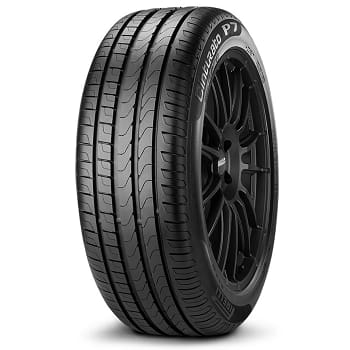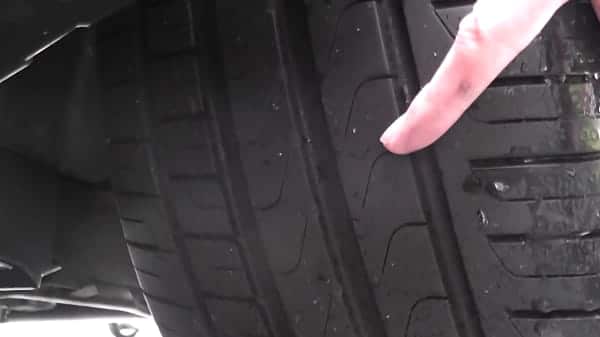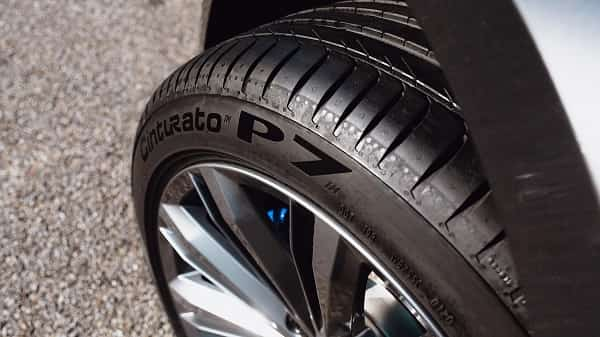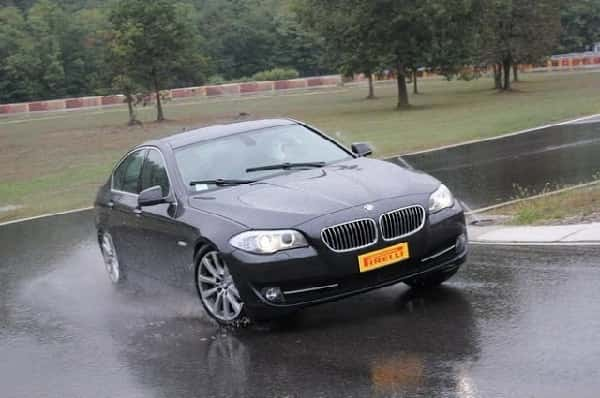
Pros
- Excellent longitudinal traction and handling on dry roads
- Responsive and linear steering
- Very good hydroplaning resistance
- Surefooted handling in rainy conditions
- Short stopping distances on wet tarmac
- Exceptional ride quality over broken surfaces
- It doesn’t become too noisy on the highway
Cons
- Longer stopping distances on dry roads than the best-in-class tires
- No treadwear warranty
- Relatively high wear for a touring tire (and higher than its closest competitors)
The North American market isn’t very welcoming to summer tires. Almost every category that I know of is more popular when paired with an all-season tread compound, and that includes touring and grand-touring tires.
Meanwhile, the European market enjoys the benefits of summer grand-touring tires much more.
However, we’ve seen a shift in recent years, with people in southern areas asking for summer touring tires. And for a good reason – they offer vastly better traction and grip, both on dry and wet surfaces.
Now, sure, all-season grand-touring tires provide you with some traction on snow, but not enough for harsh wintry conditions.
Hence, if you want the best possible performance and highest safety throughout the year, a combination of summer and winter tires is recommended. If you go that route, you might want to have a look at the Pirelli Cinturato P7.
It’s a summer touring/grand touring tire designed to provide you with a safe and comfortable ride on dry and wet roads, particularly in warmer conditions. It should also do much better than your regular all-season grand-touring tire, and by a significant margin.
Still, there are some downsides to owning a summer grand touring tire. For starters, the Cinturato P7 won’t last nearly as long as its all-season brother (Cinturato P7 All Season Plus II).
Summer tires, in general, have lower treadlife, meaning you’ll have to replace them sooner; it’s the price you have to pay for the increased performance and safety.
But how much difference does the summer compound make? And should you splurge the cash for a set of these tires? You will find out everything there is to know about the Pirelli Cinturato P7 in my in-depth review.
I’ll cover the most important things of the tire, including dry and wet performance, treadlife and wear, and comfort. Let’s dig in!
Contents
What are the Specifications and Maintenance Indicators?
The Pirelli Cinturato P7 is a summer grand-touring tire, although Pirelli also markets H-speed and V-speed rated models are performance tires.
It comes in 16-inch and 17-inch sizes, so it’s aimed mostly at compact cars, such as the Corolla and Civic, and mid-size sedans like the Camry and Accord.

As for monitoring wear and tread depth, the Cinturato P7 uses the industry-standard TWIs (tread wear indicators). These are narrow rubber bars that sit recessed into the tire’s circumferential grooves.
You can see them even when the tire is new, but they will become more visible as it wears down.
For summer tires, the minimum tread depth is 2/32-inch, which is considered the minimum for good hydroplaning resistance. Anything less than that, and the tire won’t be able to dissipate water out of the tread, resulting in seriously worsened stability and traction in rainy conditions.
When the tread reaches 2/32-inch depth, the indicators will become flush with the surface, meaning you should immediately replace the tires. If not, you risk your safety (and that of others), but you also run into trouble with authorities.
Unfortunately, the Cinturato P7 isn’t a particularly durable tire, with owners reporting around 20,000 miles of usage between replacements.
That’s much less than comparable all-season tires but also worse than some premium summer grand-touring tires.
To make things worse, Pirelli doesn’t provide any treadwear warranty for the tire.
Features and Performance of the Pirelli Cinturato P7
The Cinturato P7 features quite a few advanced technologies, aiming to improve performance without sacrificing treadlife and increasing rolling resistance.
The last part was of particular interest to Pirelli, as most of its competitors offer some sort of low-rolling-resistance technology.
Hence, the P7 features a tread compound with advanced polymers, reducing CO2 emissions and improving fuel economy.
The technology is particularly useful in the Ecoimpact branded sizes, which provide even higher energy efficiency and lower rolling resistance.
That’s all nice, but most people care about how the tire performs on the road, rather than the 5% fuel it will save.
Let’s have a look at what Pirelli did to improve on-road performance and if it makes a difference in the real world in our Pirelli Cinturato P7 review.
1. Dry Grip and Traction
The Cinturato P7 features robust shoulders and a continuous rib on the outboard portion of the tire, which improves lateral grip when cornering.
As a result, the handling is excellent for the category, and much better than what you’d get on all-season tires.
Specifically, the P7 feels very surefooted in the corners, even when pushed hard. The lateral grip is very high for a road tire, so you can drive more enthusiastically.
Meanwhile, you won’t be able to do that with a set of all-season tires. The acceleration traction is also excellent, meaning you can push hard out of a corner.

However, the Cinturato P7 struggles in one area, and that’s braking.
Namely, the stopping distances aren’t very long, but they are also not as short as on other premium summer grand-touring tires. It surprised me, to be frank, although it shouldn’t be a big deal for most.
Still, overall, most drivers will be completely satisfied with how this tire drives.
The traction and grip are excellent, and although the braking distances are longer than the premium competition, they are still better than most budget tires.
2. Handling and Steering Feel
Just like Italian cars, Pirelli tires are famous for the experience they provide behind the steering wheel. Notably, most tires from the company provide responsive steering with a lot of feel from the road.
So, how does the Cinturato P7 fare in this category? Well, it’s miles better than any all-season touring tire – the summer compound really makes a difference here. But even when compared to other tires in its category, it remains a strong contender.
Particularly, the front tires respond quickly to the driver’s input, especially in models with higher speed ratings, which Pirelli markets as performance tires.
The steering is also very linear, both initially and mid-corner, which further improves the driving experience.
Lastly, you will always know when the tires lose traction, connecting you more to the driving experience.
Overall, I was very pleased with how this tire feels. It connects with the driver quite well for the category, improving the daily drive quite a bit.
3. Wet Grip, Traction, and Braking
Summer tires usually excel in rainy conditions, and that’s especially true for grand-touring and high-performance models.
How, you ask? Well, the stickier tread compound works wonders to improve traction on wet surfaces, despite the fact that summer tires don’t have a very aggressive tread compound.
Even so, the Cinturato P7 packs four circumferential grooves for higher water evacuation, improving the hydroplaning resistance.
As a result, the tire is very good in rainy conditions overall. The cornering feels surefooted without sacrificing the responsive nature of the tire.
And even when you push too hard, your vehicle will exhibit understeer over all four wheels, which is easy to correct by slowing down.
The hydroplaning resistance is also excellent, so you don’t have to worry about losing stability in very heavy rain.
Finally, the stopping distances are among the shortest in the category.
As a whole, the Pirelli Cinturato P7 is much better than any all-season grand-touring tire in rainy conditions and among the best in its respective category.

4. Should You Use It Through the Winter?
The Pirelli Cinturato P7 is a summer tire, which means you should absolutely not use it in freezing temperatures, even if it doesn’t snow.
That’s because the tread compound can crack in cold weather, rendering your tires unusable when winter arrives.
Besides, the Cinturato P7 won’t provide you with enough traction in wet and cold conditions, especially when compared to all-season and winter tires.
Hence, I recommend investing in another set of winter tires, or at least all-weather tires, which will provide you with much better overall performance.
Comfort and Road Noise
People often associate summer tires with high noise, but that’s mostly because, in North America, most summer tires are of the high-performance variety.
Meanwhile, the Cinturato P7 is a grand-touring summer tire (although it does come in some low-profile sizes), meaning you should get lower noise characteristics.
On top of that, Pirelli employed an asymmetric tread pattern, which was carefully designed so that it minimizes growl.
As a result, the Cinturato P7 is a very quiet tire, even on some rough patches of the road.
With a set of these tires, your long drives will be much more bearable, and your family will be quite happy about that.
Okay, but what about the ride quality? Fortunately, the Cinturato P7 also excels in that area. Smaller imperfections are not an issue at all, but the tire is also good at absorbing larger impacts.
Particularly, there is no unnecessary information traveling into the cabin, meaning you won’t feel the bumps as much.
Overall, I was very pleased with how smooth the Cinturato P7 is. More importantly, it shows that summer tires can also be quiet and comfortable.
You can see more Pirelli Cinturato P7 review here: Video created by ReviewsOnAnything
Should I Buy the Pirelli Cinturato P7?
The Pirelli Cinturato P7 is a tire with some glaring compromises, particularly the shorter treadlife and the slightly longer stopping distances on dry roads.
However, if you can live with that, it will reward you with a responsive driving experience, strong performance in dry and wet conditions, and a very smooth and quiet ride.
Hence, if you are looking for a tire that’s safe and fun to drive, you should consider the Cinturato P7.
What vehicles will the Pirelli Cinturato P7 tire be suitable for?
Below is a list of some popular vehicles, however this is not a complete list.
- Acura CL, TL, TSX, RL, RLX, RSX
- Audi RS6, S6, TTS Quattro, TT Quattro, A3, A4, A5, A6, S4, S5, S8, A8 Quattro
- BMW X3, X4, M3, M4, M5, Z4, 128i, 228i, 330i, 525i, 530i, 550i, 640i
- Buick Regal, Skylark
- Chevrolet Epica, Cobalt, Sonic, Cruze, HHR, Malibu, Volt, Orlando, Corvette, Uplander, Trailblazer, Impala, Camaro
- Chrysler Sebring, PT Cruiser, 200, 300M Special, Prowler, LeBaron
- Dodge Stratus, Neon, Stealth, Dart, Avenger, Daytona
- Ford EcoSport, Fusion, Mustang, Crown Victoria, Escape, Freestar, GT
- Honda Accord, HR-V, Clarity, Civic, S2000
- Hyundai Sonata, Kona, XG350, Genesis Coupe, Venue, Azera, Tucson, Elantra, Ioniq, Tiburon
- Kia Magentis, Niro, Optima, Rondo, Soul, Stinger, Cadenza, Sportage, Amanti, Forte
- Mazda 3, 5, 6, RX-7, RX-8
- Mercedes-Benz
- Mercury Milan, Sable, Grand Marquis LS, Monterey
- Mitsubishi Lancer, Galant, Outlander, Eclipse, Starion, 3000GT
- Mini Cooper
- Nissan Sentra, Kicks, Altima, 350Z, Juke, Maxima, Rogue, Leaf
- Porsche 911, Boxster, 928, 968, Cayman
- Subaru Legacy, Impreza, Forester, WRX, Crosstrek, Forester, Outback
- Suzuki SX4, Verona, Kizashi
- Toyota Camry, Prius, Solara, Avalon, Mirai, Sienna, Corolla, Matrix, Supra
- Volkswagen Jetta, Golf, Beetle, Passat, Tiguan, Phaeton
- Volvo C30, C70, S40, S60, S80, S90, V50, V60, V70, XC70
List of the Pirelli Tires Review
I’m Ivo Gievski, the content writer for Tireer. We built our website with over 15 years of experience and extensive research in the automotive and technology sectors. My dedication to delivering high-quality content is unwavering, and I strive to continuously hone my skills to stay ahead of industry trends and provide readers with informative, engaging, and valuable insights.